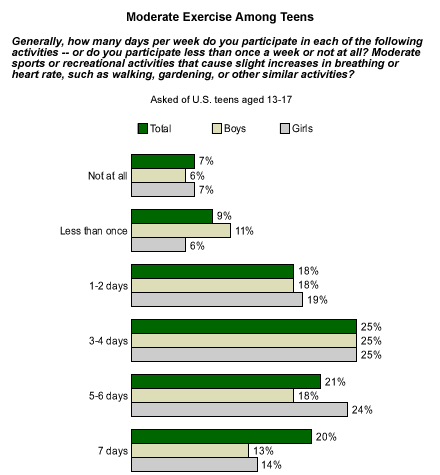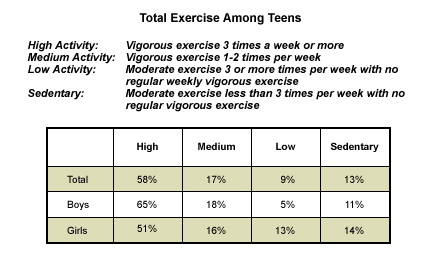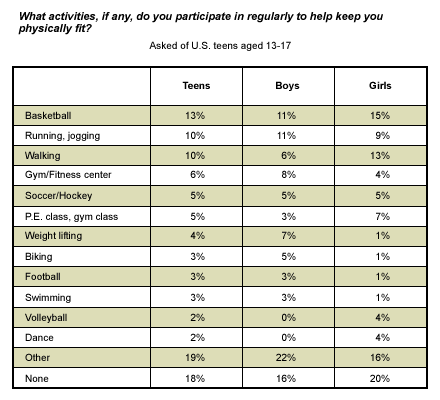Obesity is a major health risk for children in the United States. According to a recent report by Duke University researchers, "Childhood obesity has risen to the point that it can be considered a modern-day epidemic." Regular exercise among youth is clearly one of the key ingredients necessary to reverse this disturbing trend.
A recent Gallup Youth Survey* shows that although American teens as a whole report fairly high levels of exercise, a significant proportion are not getting their fair share. In fact, some teens are simply couch potatoes -- nearly a quarter (23%) say they participate in vigorous sports or physical activities less than once a week. A somewhat smaller percentage of teens -- 16% -- engage in moderate exercise less than once a week.


The Centers for Disease Control and Prevention (CDC) estimates that nearly 16% of the nation's 12- to 19-year-olds are overweight, and the number of overweight teens has been growing markedly since the 1970s. Given the rising rates of obesity and the medical complications that can arise from it, including type 2 diabetes, it is more important than ever for teens to make regular exercise an integral part of their lifestyles. CDC research has also shown that kids who are physically fit are more likely to maintain beneficial exercise habits into adulthood, although Gallup surveys of adults show that levels of exercise tend to drop off as respondents' age increases.
Total Exercise
In order to get a general idea of how much U.S. teens exercise overall, Gallup developed a four-category composite using responses to the two questions about vigorous and moderate exercise. Teens were then categorized into the following exercise intensity level groupings: high activity (defined as vigorous physical activity three or more times a week), medium activity (vigorous activity one to two times a week), low activity (moderate physical activity three or more times a week), and sedentary (moderate activity less than three times per week with no regular vigorous exercise).
Overall, nearly 6 in 10 U.S. teens (58%) can be classified as highly active and 17% are in the medium category, while 22% are either in the low (9%) or sedentary (13%) groups.

U.S. teens are much more likely to fall into the high physical activity classification, and much less likely to fall into the sedentary category, than are U.S. adults, according to data collected in Gallup's annual Health poll.
The survey reveals that boys are more likely than girls to be in the highly active category, but there is no difference by gender in the number of sedentary teens. It is noteworthy (though hardly surprising) that teens who say that their weight is "about right" are significantly more likely to be in the "high exercise" group than are those who say that they are overweight (64% vs. 45%).
What Teens Do to Keep Physically Fit
The good news is that most teens have at least one activity in which they engage regularly to help keep physically fit. Basketball, jogging, and walking top the list of activities young people say they participate in. Boys and girls tend to choose different activities, but it is troubling that 16% of teenage boys and 20% of teenage girls say that they do not participate in any activities to help keep physically fit.

Bottom Line
While many children participate in organized, regular fitness activities, leading a fit lifestyle does not have to mean going to a track, basketball court, or baseball diamond. The Mayo Clinic offers some simple tips that parents can use to promote fitness, including shutting off the television, being a good role model by participating in physical activities with children, and promoting the concept of "activity" over "exercise," so that staying in shape doesn't seem like a chore. The goal is just to get kids moving, starting them young with games and other pastimes involving physical activity.
*The Gallup Youth survey is conducted via an Internet methodology provided by Knowledge Networks, using an online research panel that is designed to be representative of the entire U.S. population. The current questionnaire was completed by 785 respondents, aged 13-17, between Jan. 22 and March 9, 2004. For results based on the total sample, one can say with 95% confidence that the maximum margin of sampling error is ±4 percentage points.